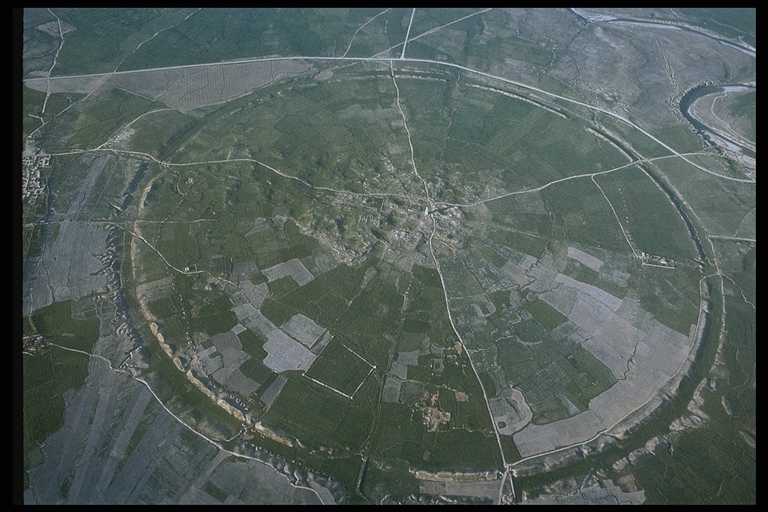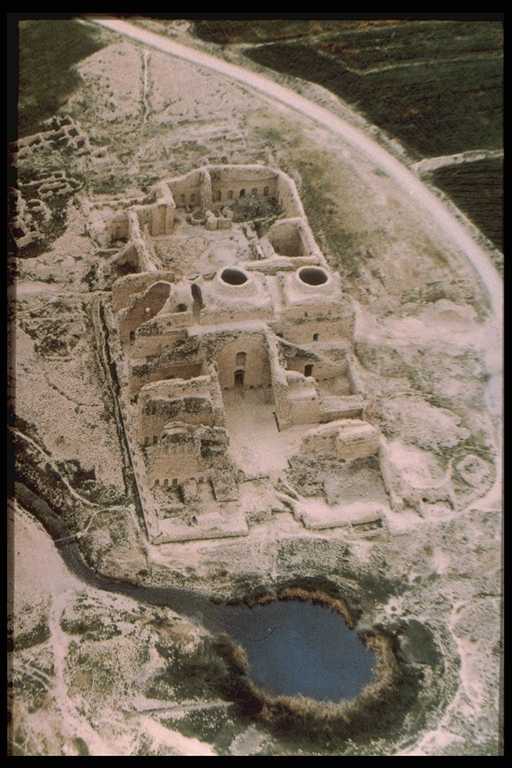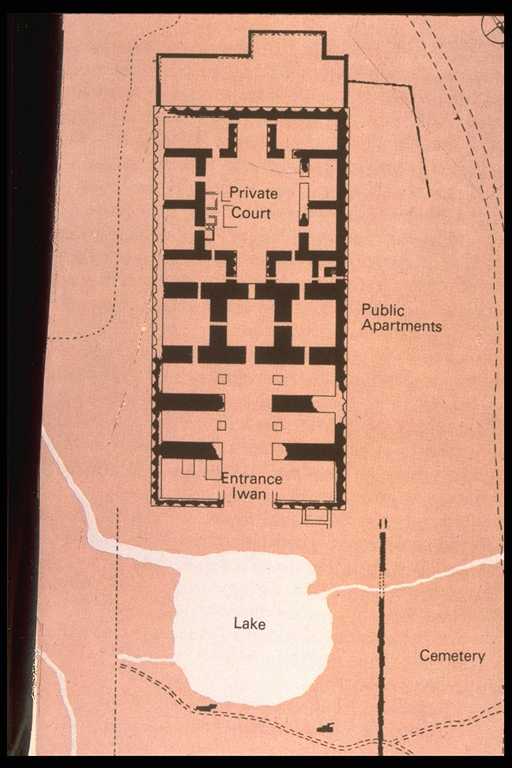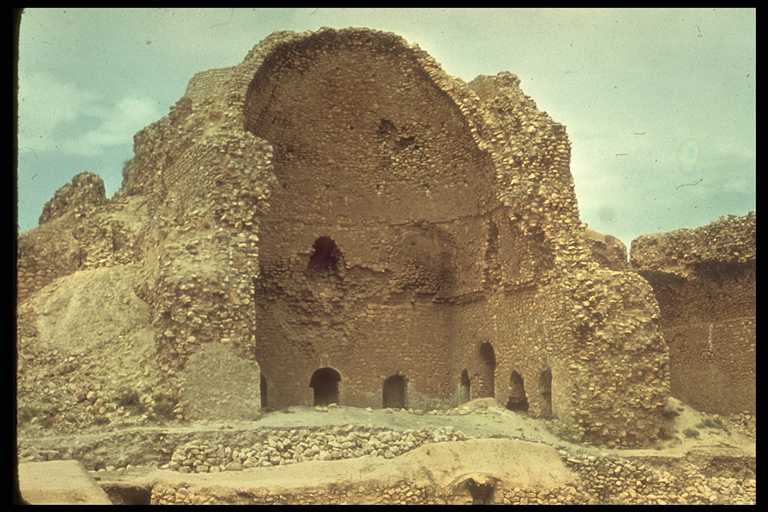Hatra was surrounded by two round walls, and had a large temple complex in the center. Another Parthian city Darabjerd in southern Iran, had two rock formations within its perfectly circular wall: one a castle, the other a temple.
Modern Firuzabad, known as Gor and Ardashir-Khorra (“Glory of Ardashir”) in Sasaian times, is said to have been founded by Ardashir I (AD 224-241), Gor was Ardashir’s stronghold in his revolt against the last Parthian king. The Sasanian town was a round city encircled by double walls separated by a 35 m wide ditch pierced by four axial city gates. The plan of the town was a perfect circle, 1,950 m in diameter, divided precisely into twenty sectors with radial concentric streets.

Arial photo of ruins, from Berghe, Louis Vanden


Fire Temple, from, Cultural Heritage of Fars
“A walled central inner city probably housed official buildings at the center of which stood Ardashir’s fire temple, represented by stone building known as Takht-e Neshin.”
“The building was a long rectangular structure divided into a reception area backed by residential quarters. A long entrance hall, or ayvan, led into a high domed room, the principal audience chamber which was flanked by other domed rooms that occupied a 14m wide area on the north side of the palace. To the south, a smaller ayvan led to an inner courtyard backed by a second axial ayvan. The barrel-vaulted rooms that surrounded the courtyard constitute the residential part of the complex.”

Adashir’s Palace from Herrmann, Georgina
“Ardashir’s palace is a monumental structure of rough stone and gypsum mortar, built without fortifications, after his accession. Rectangular halls in the palace were roofed with domes constructed of rubble and gypsum mortar. This exceptionally strong and resilient dome rested on a transitional zone that transformed the rectangular walls of the room into a circular base for the cupola through the use of a small arch, the squinch, built above the four corners of the walls. This modest invention was eventually elaborated, and magnificently embellished with colored mosaics and tiles, in the later domes of Islamic Iran.”
References: Spiro Kostof, The City Shaped, 1991,
Excerpts from The Near East in Late Antiquity: The Sasanian Empire, University of California, Berkeley
Related Post: |
Social Bookmarking
2 comments:
Hello Mazlin!
Kyle is in love with this article about the circular city! He thinks that is the neatest thing and wants to live there.
I thought you might want to know ;).
I hope your weekend was good!
Svet
When I first arrived in view of the metropolis I was looking out and down from a window hovering above… the room I was in was completely dark and I was alone. Looking out and down I saw a city that was larger than any city I’d ever seen before. I noticed that all the structures seemed to circle in towards the center. It was huge expansive intricately embroidered with technical diversity… architecturally abstruse at its center the buildings were opaque blackened not unlike crystal formation… extending to odd heights and angles. Out from the center the architecture started to blend into buildings of mason stone and steel. As I looked closer I started to notice that there were long white cylinder trains that spiraled in and out from the city center…in this city there were no cars. At this moment of realization that this city is absent of cars and all the cities I know are completely infested by them I questioned: Where am I. I observed deeper into the city. I was amazed by the diversity of structures and marveled at the silhouettes of the people in motion. It was truly immense. I moved away from the window trying now to adjust my vision inwards this darkened room, I moved with my hands sweeping the area in front of me trying to feel something… arriving with my palms flat on a wall that echoed ever so faintly with the rhythm of motion. I let my hands guide me through the dark following the smooth wall until I arrived back to the window where I looked out once more. It appeared that in my absence from the window we had gained some elevation. I could now see that the city was in fact circular with a diameter approximately ten miles across and that the entire inner city was environed by a garden/green belt maybe one mile wide. In this green belt I saw pebbled pathways, sculpted gardens and the like… with the faint details of people in motion. The trains continued to spiral outwards/inwards missing this area all together. Just then we gained more elevation and I could see for miles now. Out from this green belt was what appeared to be the agricultural belt… it was by far the largest area of the metropolis approximately twenty miles wide extending the entire perimeter of the whole… lakes and streams were in abundance…I could see greenhouses, open farmlands… grain and orchard. In other areas there were cattle grazing, horses, and other livestock. The trains continued their spiral inwards/outwards towards the last perimeter of the whole. The entire area was environed by what appeared to be a brick building approximately ten stories high. I could only guess that this is where some of the people lived as well as where some of the goods were stored and I could only imagine how well these people lived. Beyond the outer building that enclosed the metropolis within there was the natural landscapes, forests, and terrain. How amazing the view out this one window could be I was completely overwhelmed. I imagined for a moment the wealth and pride each member of this society must enjoy as they looked out their windows each day. Out one side they could see the wilderness beyond and out the other they looked into their farmlands towards their city center. Beyond the city heading off in straight lines through the forests I saw the faint detail of the trains heading out towards other circular cites in the distance, and beyond the horizon..
Post a Comment